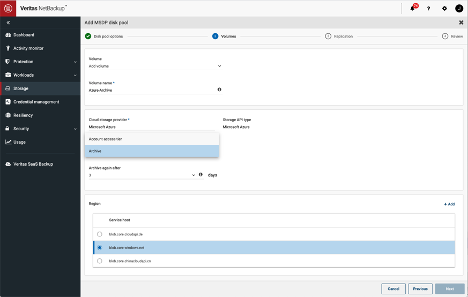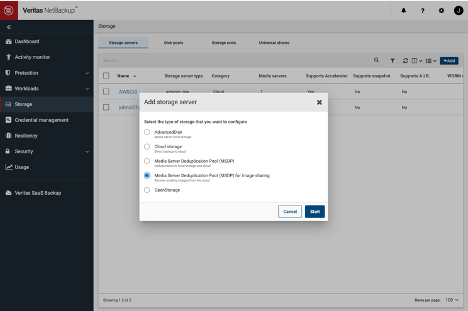What’s New in the Cloud With NetBackup 9

At the end of January, Veritas launched NetBackup 9. With this release, we introduced an extremely powerful new deployment option: NetBackup Flex Scale for scale-out infrastructure. This amazing new development means that the power of NetBackup is available on just about any infrastructure style out there. With the option to use software-defined, Build-Your-Own (BYO), purpose-built appliances; Virtual and Cloud Deployments; and now super-easy, scale-out architecture, NetBackup can truly go anywhere and do anything. NetBackup is designed to ensure business-critical resilience, streamline data protection management, and deliver customer choice. All this from a single platform supporting any workload, any cloud, any data source, and any deployment architecture—all at scale.
With the NetBackup 9 release, there are notable additions for cloud services, including:
- Deduplication to Azure Archive
- Simplified API and UI updates for MSDP Cloud Recovery Servers
- Incremental support for Azure Snapshots
- Amazon Machine Image (AMI) independent volume-level snapshots
- Managed Disk Support for Azure Stack
- Supercharged support for OpenStack
To reflect, NetBackup 8.3 released in July 2020. Then, it introduced the extremely easy-to-use, easy-to-configure MSDP Cloud Tier. Building off the CloudCatalyst feature, MSDP-C makes deduplication to low-cost object storage tiers such as s3, Blob, or Glacier tiers extremely easy to configure and use. NetBackup 9 strengthens this functionality as Veritas expands and optimizes support for the cloud. (To learn more about this, check out my earlier blog post for more details: Smooth sailing into cloud storage with Veritas NetBackup.)
With NetBackup 9, we’ve added support for deduplication to the Azure Archive tier. You can check out the intuitive and simple configuration in the process by reading my earlier blog post. Setting up the Azure Archive tier is simple. All you need to do is add a new cloud tier and select the Archive tier during the configuration process. (See image 1 below.)

Keep in mind: If an MSDP pool has already been set up to write to a cloud tier such as AWS s3, Glacier/Deep Archive. or Azure Blob Hot/Cold storage, that is not an issue at all—feel free to add additional cloud tiers to the same MSDP server to optimize your cloud environment. With MSDP-C there is robust multi-cloud, multi-tier, and multi bucket support to fit any business need and infrastructure need you might have.
Another great feature of the MSDP cloud tier is that the data stored in object storage is completely self-descriptive. This means that you can attach a NetBackup server to that bucket from anywhere and be able to recover the data. This Image Sharing feature has no impact on the original server or ongoing backups to cloud storage. Image sharing means that backup data in the cloud can be used for a number of things, from general cloud data reuse, to cloud-based data analytics, and of course for cloud recovery including VM conversion. The Cloud Recovery Server can even be launched from Public Cloud Marketplaces on demand. The NetBackup Resiliency feature can even completely leverage the Cloud Recovery Server as it automates large-scale migration, DR, or test operations.

In the NetBackup 9 release, the deployment of a Cloud Recovery Server, either in the cloud or on a secondary data center was simplified. It can be done easily either via API automation or in the NetBackup web UI storage configuration. (See image 2 above.) With a few simple options, a user can attach to an existing bucket and be ready to recover from it in a matter of minutes.
When it comes to snapshot protection for cloud-native workloads, NetBackup CloudPoint has added support for Azure Incremental Snapshots. With this new change, snapshots of managed disks will operate incrementally, automatically mapping changes, and only storing the changed blocks. This can dramatically cut the costs of snapshot protection by allowing for as many as 200 incremental snapshots for one full snapshot. CloudPoint also introduced support for encrypted volumes in both Azure and GCP. NetBackup 9 expands support for Azure Stack in this release as well, adding support for Managed Disk Protection. This helps deliver more complete protection of Azure Stack storage deployments.
In AWS, CloudPoint has added support for AMI-independent volume-level snapshots. This allows for volume snapshots to happen without having to quiesce the entire host. Therefore, the job can focus on quiescing the workload on the disk and then creating the volume snapshot without impacting the host overall.
When thinking about private and public cloud, NetBackup 9 also significantly supercharged our support for OpenStack both on-premises and in public clouds. NetBackup for OpenStack provides cloud-native, streamlined data protection of OpenStack workloads with:
- Agentless, API-driven automation
- Efficient resource utilization
- Built-in multi-tenant control
- Rapid, end-to-end, point-in-time granular recovery from edge to core to cloud
The main highlight of the NetBackup 9 release is the new, hyperconverged NetBackup Flex Scale deployment options. This update is proof that we are investing heavily in cloud infrastructures and will continue to do so.
Only NetBackup supports more than 800+ different data sources, 1,400 storage targets, and 60+ clouds. It can be deployed in any form factor, in any deployment mode—scale-up, scale-out, and cloud-native—all from a single, unified platform. That’s why 87% of the Fortune Global 500 choose Veritas NetBackup.
Ready to upgrade or renew NetBackup? Contact your preferred Veritas Channel Partner or Veritas Account Manager today to discuss your options. If you're unsure who to contact, email our Customer Care team or request a call from our Sales Team.
Did you miss our Conquer Every Cloud virtual conference? Watch this session led by myself and Maya Zhou, Principal Software Engineer, to learn how to dramatically reduce cloud costs with ease.

To learn more about the exciting new features in NetBackup 9, check out:
- NetBackup 9 Data Sheet
- NetBackup for Cloud solution brief
- NetBackup for Azure Deployments white paper
- NetBackup for AWS Deployments white paper
- NetBackup for Long-term Cloud Data Retention white paper
- Top 5 Reasons to Upgrade to NetBackup 9
- What’s New in NetBackup 9
- NetBackup version comparison chart
